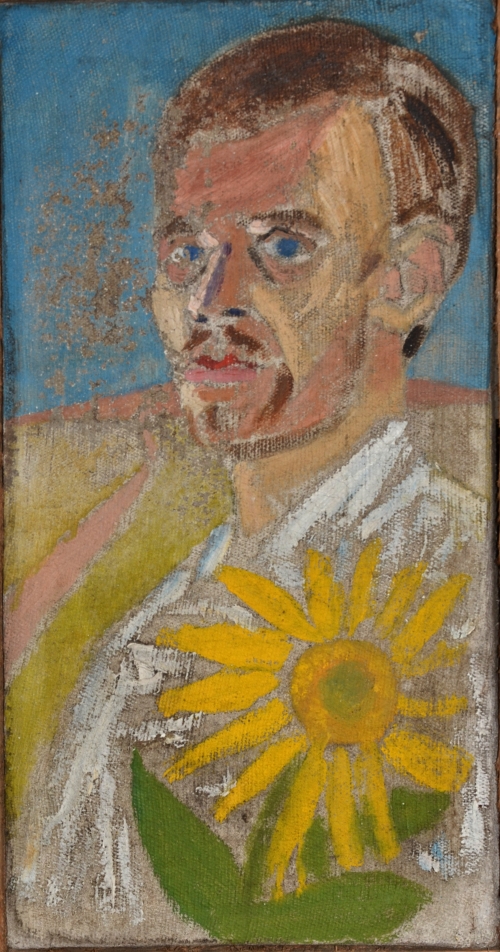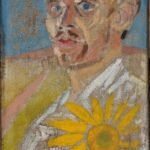
Stankevičius – Stankus Julijonas Algimantas
Painter
Born in 1933 in Aukštakalnis, Kaunas District
Died in 2002 in Strūna, Švenčionys District (buried in Vilkija)
Biography
From 1953 to 1959, he studied textile design at the State Art Institute of the Lithuanian SSR (served in the Soviet army from 1955–1958). He did not complete his studies.
In 1960, he held his first exhibition.
From 1965 to 1974, he attended a visual arts club at the Kaunas Trade Union Cultural Palace and often visited Pažaislis Monastery.
In 1978, he was placed in the Duseikiai care home and from 1980 until his death, lived in the Strūna psychiatric care facility in the Švenčionys District.
His works are held in Lithuanian museums, in the Jane Voorhees Zimmerli Art Museum (USA), and in private collections in Lithuania and abroad.
Artistic Context
Algimantas Julijonas Stankevičius-Stankus was a true marginal figure in Lithuanian art history. His closest connection was with Ričardas Povilas Vaitiekūnas, who helped preserve his legacy. He is loosely associated with a circle of outsider artists including Antanas Martinaitis, Kęstutis Paliokas, and Justinas Mikutis.
Due to his incomplete formal education, Stankus was excluded from the official Soviet art scene. As a semi-self-taught artist (and later affected by mental illness), he freely created stylistically eclectic works — portraits, landscapes, figurative compositions, drawings, and handcrafted objects.
Two main periods of his painting are typically identified:
Professional/early period (ca. 1960–1975)
Primitive or outsider period, often blending into one another.
His paintings — particularly his numerous self-portraits and figurative compositions — are noted for their vivid color sensitivity, sometimes compared to Pierre Bonnard, and for their psychologically charged symbolism reminiscent of Vincent van Gogh.
Shift in Style
After being institutionalized in 1980, his style changed radically. He no longer painted with oils on canvas and instead created works using markers and watercolors — a transition partly caused by his environment and mental health. This later style aligns more closely with art brut aesthetics.
He often drew from life (such as the care home’s towering chimney) but most of his works fused reality and imagination with historical references and grotesque, visionary symbolism. Sometimes style overtook narrative, while in other pieces, storytelling became the key to decoding complex forms.
The “Green Notebook”
A truly unique creation in Lithuanian art history is his “Green Notebook”, started in 1953 — referred to by contemporaries as “the diaries of an era.” In it, Stankus glued or sewed in all kinds of labels and fragments from Soviet life: alcohol, cigarette, medicine, matchbox, and food product labels, press clippings, event tickets, coins, and even metal lids from canned goods.
It is considered a precursor to Eastern European conceptual art.
Thus, Stankus is significant not only for his paintings or drawings but for the tapestry of his life and artistic practice — far richer and more layered than can be captured by categorizing his work into styles or movements.
Against the backdrop of his tragic, exceptional life, his multifaceted art resonates with even greater emotional depth.
— Kęstutis Šapoka
Solo Exhibitions
2013 – Painting and the Green Notebook, VAA Exhibition Halls Titanikas, Vilnius
2003 – The Green Notebook, Gallery O11, Vilnius; Gallery Kairė-Dešinė, Vilnius
1999 – Julijonas, Do You Still Love Marx? Paintings, Drawings. Giedrė Bartelt Gallery, Berlin
1997 – Gallery Lietuvos aidas, Vilnius
1995 – Contemporary Art Centre, Vilnius
1989 – Lithuanian Artists’ Palace, Vilnius
1974 – Cinema Vilnis, Kaunas
1966, 1973 – Paintings, Vilkija Cultural Center
1960 – Vilkija City Library
Group Exhibitions
2006 – Self-Portrait Exhibition, Giedrė Bartelt Gallery, Berlin
2000 – Group “24” Exhibition, Grosvenor House, London
1999 – Group “24”, Gallery Lietuvos aidas, Vilnius; Lithuanian Artists’ Drawing Exhibition, Klaipėda Art Exhibition Hall
1998 – Drawing Exhibition, Gallery Arka, Vilnius
1997 – Silent Modernism in Lithuania: 1962–1982, Contemporary Art Centre, Vilnius
1996 – Still Life in the 1970s–80s, Gallery Lietuvos aidas, Vilnius; Self-Portraits, Gallery Lietuvos aidas, Vilnius
1994 – Exhibition of Acquired Works 1991–1993, National Gallery of Art, Vilnius
1992 – Easter Art Exhibition – Were Our Hearts Not Burning, Contemporary Art Centre, Vilnius
1982 – Group “24”, Art Exhibition Halls, Vilnius


